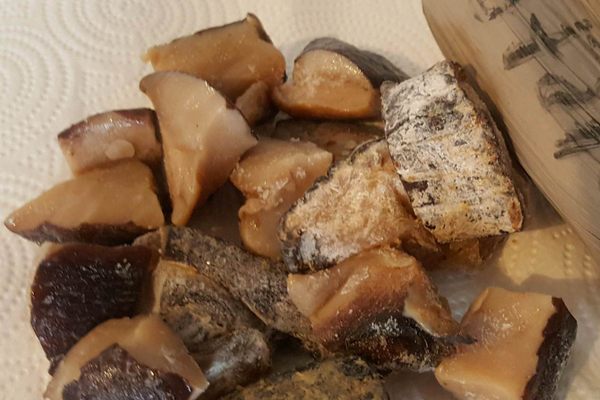Prepared Foods
Hákarl
Iceland's fermented, dried shark smells like urine and can taste like strong cheese.
Greenland sharks are the world’s longest-living vertebrates, often partially blind, and can grow up to 24 feet long. Also, their meat is poisonous. Eaten fresh, it can cause a powerful, uncomfortable intoxication. But this didn’t stop clever Vikings from figuring out that burying pieces of the massive sharks under rocks and dirt for several weeks would neutralize these toxins. After digging them up, they would hang the meat so it could age some more. The result is pungent hákarl, which is both loved and hated by Icelanders.
The uric acid present in fresh Greenland shark contributes to its ammonia-like smell. Soft, white hákarl from the shark’s body has a cheese-like texture, while reddish meat from the belly is chewier. Those who sample it describe the flavor in far-ranging terms, from fishy and mild to strong like blue cheese. Most agree that the lingering aftertaste can be described only as urine. Chunks of hákarl are often washed down with a shot of Brennivín.
Hákarl is fermented in containers instead of dirt these days, and the majority of the country’s supply is produced at the Bjarnarhöfn Shark Museum. Tourists often sample it, but hákarl is also a component of the midwinter þorramatur meal, celebrated during the Þorrablót festival. A celebration with pagan origins, the Þorrablót was revived in the 19th century and features svið (boiled sheep’s head) and súrsaðir hrútspungar (sour rams’ testicles) alongside hákarl. While curious tourists and the Þorrablót survive, so too will hákarl.
Where to Try It
-
Bjarnarhöfn Shark Museum
Bjarnarhöfn, IcelandAt this museum, visitors can watch hákarl being made.
-
Randulf's Sea House
Strandgata 96, 735, Eskifjörður, IcelandThis remote eatery and museum is located in a small Icelandic fishing town and serves up regional specialties.
Written By
 Anne Ewbank
Anne Ewbank
Sources
- www.geerg.ca/greenland-shark.html
- www.iceland.is/the-big-picture/people-society/traditions/thorrablot/
- www.vice.com/en_us/article/ywz8eg/my-hunt-for-the-400-year-old-shark-whose-flesh-gets-you-high
- www.willflyforfood.net/2017/08/31/iceland-hakarl-an-acquired-rotten-taste/
- www.iceland.is/the-big-picture/people-society/traditions/thorrablot/
- books.google.com/books?id=3ilvBQAAQBAJ&pg=PT177&dq=hakarl&hl=en&sa=X&ved=0ahUKEwiL59DrnqPXAhXQzKQKHcMPBmQQ6AEIPzAE#v=onepage&q=hakarl&f=false
- video.nationalgeographic.com/video/iceland_rottensharkmeat
- www.businessinsider.com/eating-hkarl-in-iceland-2014-4




















